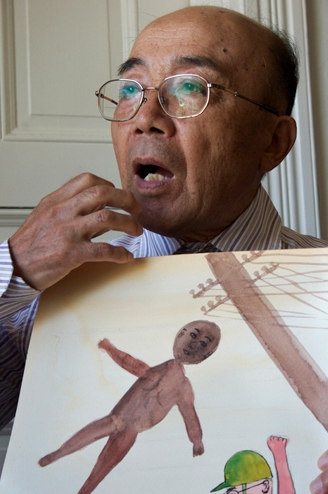Witness to Hiroshima

Sudden Fire
Witness to Hiroshima
Directed by Kathy Sloane
Available on DVD from www.witnesstohiroshima.com
By David McReynolds
Hiroshima/Nagasaki: Perhaps darkness and total silence is the best documentary. Perhaps there is no way to grasp this. Most of you reading this review were not alive when that sudden, unexpected fire disintegrated Hiroshima. I was a kid at a Baptist summer camp in the California mountains when word came. My father, then in the Army Air Force, had gone to Hiroshima shortly after the war to examine the destruction. Our family has always wondered if his fairly early death from cancer was not a result of that visit. If I’ve felt a special link to Hiroshima/Nagasaki, it was because my father’s work was with the B-29, the plane that delivered the bombs.
I’ve been to Hiroshima several times; it is a totally new, rebuilt, and fairly nondescript city. Only in the central area, where the bomb exploded, have the ruins remained.
At one level there was nothing so special about Hiroshima or Nagasaki. The Allied forces did the same thing to Dresden late in the war, destroying one of the great cities of Germany and one which had not been a military target. In the firebombing of Tokyo, more people died in a single night than died in Hiroshima.
Of course, those horrors required vast fleets of aircraft and tons of bombs. They were, we can see looking back, very different from the limited damage the Germans inflicted on London. Before Hiroshima, that war had reached a new level. At the time, the destruction of whole cities by fire seemed only a small step in the dance of war.
But Hiroshima was unique. It stays with us. It haunts us. No fleet of planes was needed. A single B-29, flying in seeming innocence above the city, dropped a single bomb that floated down, and then suddenly the city vanished. That was new. It made us pause.
This short documentary tells the story of the bombing of Hiroshima through watercolors drawn by Keiji Tsuchiya, who was 17 years old and in Hiroshima when the bomb exploded.
Good though its intentions are, and effective as the soundtrack is, this documentary is trying to deal with something too terrible for the narration of the watercolors. It is also set at an odd angle by the concluding discussion of the horseshoe crabs and Keiji Tsuchiya’s work to help preserve them—noble work, but not related to the bombing.
However, I welcome anything to help remind us that Hiroshima and Nagasaki may have happened over 60 years ago, but several nations are well equipped to destroy all life on earth if the next war goes nuclear. How frustrating it is to hear the United States, which is the only nation ever to use a nuclear weapon, threaten Iran if it dares to follow the examples of the United States, Russia, France, Britain, China, North Korea, India, Pakistan, and Israel by developing a nuclear bomb. Let those who preach set our imaginations on fire by actions—by the beginning of unilateral nuclear disarmament by the United States.
